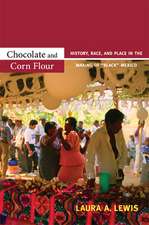The Magazine Novels of Pauline Hopkins: (Including Hagar's Daughter, Winona, and Of One Blood): The Schomburg Library of Nineteenth-Century Black Women Writers
Autor Pauline Hopkins Introducere de Hazel V. Carbyen Limba Engleză Paperback – 12 iul 1990
Din seria The Schomburg Library of Nineteenth-Century Black Women Writers
- 22%
 Preț: 457.66 lei
Preț: 457.66 lei - 7%
 Preț: 126.63 lei
Preț: 126.63 lei - 31%
 Preț: 901.65 lei
Preț: 901.65 lei - 45%
 Preț: 356.67 lei
Preț: 356.67 lei - 5%
 Preț: 88.73 lei
Preț: 88.73 lei - 27%
 Preț: 421.21 lei
Preț: 421.21 lei - 5%
 Preț: 128.84 lei
Preț: 128.84 lei - 31%
 Preț: 800.33 lei
Preț: 800.33 lei - 45%
 Preț: 391.64 lei
Preț: 391.64 lei - 31%
 Preț: 669.07 lei
Preț: 669.07 lei - 7%
 Preț: 120.88 lei
Preț: 120.88 lei - 23%
 Preț: 456.73 lei
Preț: 456.73 lei - 30%
 Preț: 527.56 lei
Preț: 527.56 lei - 27%
 Preț: 426.18 lei
Preț: 426.18 lei - 28%
 Preț: 378.49 lei
Preț: 378.49 lei - 30%
 Preț: 573.44 lei
Preț: 573.44 lei - 28%
 Preț: 429.27 lei
Preț: 429.27 lei - 28%
 Preț: 374.04 lei
Preț: 374.04 lei - 28%
 Preț: 605.79 lei
Preț: 605.79 lei - 13%
 Preț: 186.63 lei
Preț: 186.63 lei - 9%
 Preț: 130.43 lei
Preț: 130.43 lei - 6%
 Preț: 161.24 lei
Preț: 161.24 lei - 28%
 Preț: 378.57 lei
Preț: 378.57 lei - 13%
 Preț: 76.59 lei
Preț: 76.59 lei - 28%
 Preț: 469.98 lei
Preț: 469.98 lei - 45%
 Preț: 339.77 lei
Preț: 339.77 lei - 28%
 Preț: 472.62 lei
Preț: 472.62 lei - 27%
 Preț: 496.48 lei
Preț: 496.48 lei - 28%
 Preț: 448.08 lei
Preț: 448.08 lei - 31%
 Preț: 583.31 lei
Preț: 583.31 lei - 31%
 Preț: 583.16 lei
Preț: 583.16 lei - 45%
 Preț: 338.85 lei
Preț: 338.85 lei - 28%
 Preț: 475.06 lei
Preț: 475.06 lei - 28%
 Preț: 446.99 lei
Preț: 446.99 lei - 44%
 Preț: 321.98 lei
Preț: 321.98 lei - 30%
 Preț: 535.04 lei
Preț: 535.04 lei - 28%
 Preț: 392.53 lei
Preț: 392.53 lei - 30%
 Preț: 952.42 lei
Preț: 952.42 lei - 34%
 Preț: 641.87 lei
Preț: 641.87 lei - 34%
 Preț: 768.08 lei
Preț: 768.08 lei - 7%
 Preț: 159.19 lei
Preț: 159.19 lei - 31%
 Preț: 563.58 lei
Preț: 563.58 lei
Preț: 261.86 lei
Preț vechi: 307.18 lei
-15% Nou
Puncte Express: 393
Preț estimativ în valută:
50.11€ • 52.13$ • 41.37£
50.11€ • 52.13$ • 41.37£
Carte tipărită la comandă
Livrare economică 03-09 aprilie
Preluare comenzi: 021 569.72.76
Specificații
ISBN-13: 9780195063257
ISBN-10: 0195063252
Pagini: 672
Dimensiuni: 118 x 164 x 44 mm
Greutate: 0.5 kg
Editura: Oxford University Press
Colecția OUP USA
Seria The Schomburg Library of Nineteenth-Century Black Women Writers
Locul publicării:New York, United States
ISBN-10: 0195063252
Pagini: 672
Dimensiuni: 118 x 164 x 44 mm
Greutate: 0.5 kg
Editura: Oxford University Press
Colecția OUP USA
Seria The Schomburg Library of Nineteenth-Century Black Women Writers
Locul publicării:New York, United States
Recenzii
Brilliant....It is not hard to imagine that, once her fiction is given the attention it deserves, Hopkins could replace Chestnutt as the foremost black novelist of the period.
The three novels published in the Schomburg Library for the first time since their appearance in The Colored American Magazine from 1901 to 1903 not only represent an early example of black people producing popular fiction for and about themselves, but extend the cultural and political discourse introduced in Harper's novel [Iola Leroy].
The three novels published in the Schomburg Library for the first time since their appearance in The Colored American Magazine from 1901 to 1903 not only represent an early example of black people producing popular fiction for and about themselves, but extend the cultural and political discourse introduced in Harper's novel [Iola Leroy].



























